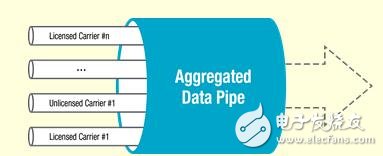Wi-Fi and LTE are moving toward convergence advantages will complement each other
Wi-Fi and cellular technology are now the two most successful wireless technologies. Over the years, they have always had complementary strengths, and at this point they seem to be merging. The demand for wireless capacity has been high – and now is the best time to promote technology convergence. But how this is done is completely different.
The biggest advantage of Wi-Fi is that it runs on an unlicensed spectrum. Anyone can deploy a Wi-Fi network and support almost any smart handheld or IoT device that people can think of. Wi-Fi is best suited for indoor applications with high capacity, high density and low mobility. On the other hand, cellular technology has swept the world in the past few decades, creating a multi-trillion dollar telecom industry with ubiquitous outdoor coverage, seamless mobility, and more perfect for voice and streaming. Such as real-time applications. The combination of the two technologies will bring great hope to the entire industry, but the question is how to combine the two. There is no doubt that these two technologies will continue to focus on providing users with the goal of “always maintaining the best connection†experience. In fact, users care about fast, reliable, and affordable technology, but they don't care which wireless technology they use.

Wi-Fi/cellular network convergence is constantly being tried in all walks of life. As each technology continues to advance, it is important to understand the difference between these different methods. In fact, the answer is not correct or wrong, but the choice is different (depending on User's reference architecture). Like everything, the market decides what method to use at the end of the day.
LTE in unlicensed bands (LTE-U and LAA-LTE)
One of the most recent choices is LTE-U. After Qualcomm and other radio access network (RAN) providers, LTE-U is a kind of LTE that runs directly on the 5GHz unlicensed band. the way. In this way, in order to get more wireless spectrum to support mobile services, the advantage in coverage will be reduced. This concept is still being developed under the 3rd GeneraTIon Partnership Project (3GPP) to comply with the Assisted Authorization Access (LTE-LAA) in the R13 (Release 13) standard.
The LAA continues to operate all LTE control and data channels in the licensed band and uses LTE-Advanced to implement channel bonding between them. Unlicensed bands are designed to provide additional data plane performance - an increase in actual data plane performance. The biggest challenge of this approach is to solve the problem of harmonious coexistence between LTE and Wi-Fi in unlicensed bands, but the shared spectrum is not the DNA of LTE (intrinsic characteristics).
According to relevant sources, LTE-U can easily coexist with Wi-Fi in unlicensed bands and ensure its operation, which is similar to the way Wi-Fi networks share frequency bands. But there are also concerns that the inherent nature of LTE will cause it to push Wi-Fi out of these bands. Unlike Wi-Fi's first-come, first-come, competitive-based access model, LTE assumes that it can fully control the frequency band in which it operates. The purpose of LTE is not to compete for access to the medium.
Wi-Fi uses a listen-before-talk (LBT) mechanism, that is, any device that wants to use this band must listen first to see if this band is occupied. If this band is not busy, the device can take up and start transmitting. This band can only be held for a maximum of 10 microseconds, after which it will be released and repeated for LBT. This ensures fair access to the medium and is a very effective way to share unlicensed spectrum. The problem that needs to be solved now is how to use LBT in the unlicensed band and get the best implementation effect, because this will require changes in the media access control layer.
If the LBT mechanism is not well implemented, the feasibility of LTE-U technology can attract customers to enter and stay may be limited, because owners of public places and other companies are reluctant to deploy any potential negative impact on unlicensed bands. facility. Public places such as hotels, convention centers, stadiums and transportation hubs are ideal places for massive amounts of data. High-quality Wi-Fi services now play a vital role in these public spaces. This will also effectively place public places on protecting unlicensed bands. Many locations now employ employees to track the use of these bands. In this way, it must be ensured that the LAA-LTE standard introduced by 3GPP supports the LBT mechanism according to the IEEE specification.
Subwoofer Speaker,Professional Speaker,Voice Coil Subwoofer,21Inch Subwoofer
Guangzhou BMY Electronic Limited company , https://www.bmy-speakers.com